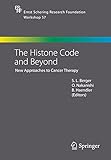The Histone Code and Beyond : New Approaches to Cancer Therapy / edited by S. L. Berger, O. Nakanishi, B. Haendler.
Tipo de material: TextoSeries Ernst Schering Research Foundation Workshop ; 57Editor: Berlin, Heidelberg : Springer Berlin Heidelberg, 2006Descripción: xiv, 209 páginas 36 ilustraciones recurso en líneaTipo de contenido:
TextoSeries Ernst Schering Research Foundation Workshop ; 57Editor: Berlin, Heidelberg : Springer Berlin Heidelberg, 2006Descripción: xiv, 209 páginas 36 ilustraciones recurso en líneaTipo de contenido: - texto
- computadora
- recurso en línea
- 9783540376330
- QH345
Springer eBooks
The Role of Histone Modifications in Epigenetic Transitions During Normal and Perturbed Development -- Nucleosome Structure and Function -- The Role of Snf2-Related Proteins in Cancer -- Imitation Switch Complexes -- How Is Epigenetic Information on Chromatin Inherited After DNA Replication? -- Polycomb Silencing Mechanisms and Genomic Programming -- CpG Island Methylation and Histone Modifications: Biology and Clinical Significance -- Histone Post-Translational Modifications Regulate Transcription and Silent Chromatin in Saccharomyces cerevisiae -- Histone Acetylation-Mediated Chromatin Compaction During Mouse Spermatogenesis -- Role of Ubiquitin-Like Proteins in Transcriptional Regulation -- Interplay of the SUMO and MAP Kinase Pathways.
Methylation of DNA at cytosine residues as well as post-translational modifications of histones, including phosphorylation, acetylation, methylation and ubiquitylation, contribute to the epigenetic information carried by chromatin. These changes play an important role in the regulation of gene expression by modulating the access of regulatory factors to the DNA. The use of a combination of biochemical, genetic and structural approaches has allowed demonstration of the role of chromatin structure in transcriptional control. The structure of nucleosomes has been elucidated and enzymes involved in DNA or histone modifications have been extensively characterized. Since deregulation of epigenetic marks has been reported in many cancers, a better understanding of the underlying molecular mechanisms bears the promise that new drug targets may soon be found. The newest developments in this quickly developing field are presented in this book.
Para consulta fuera de la UANL se requiere clave de acceso remoto.


